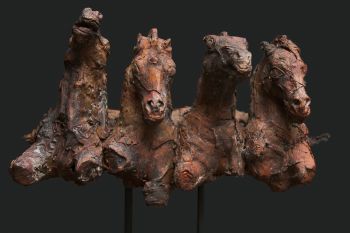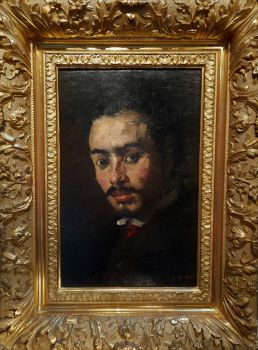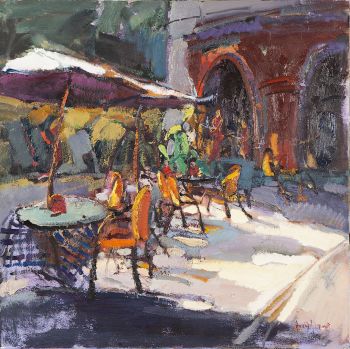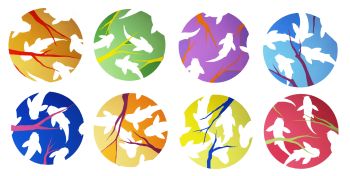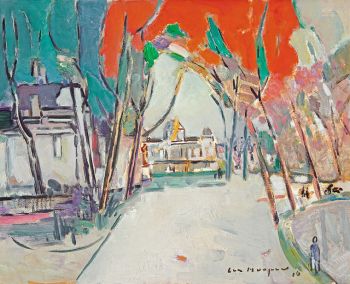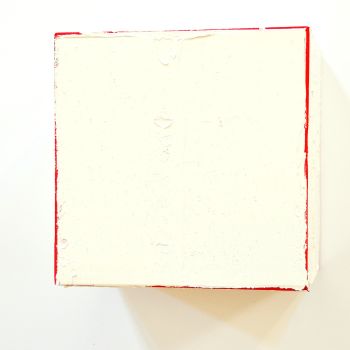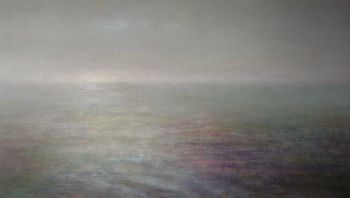Celebration of Spring 1776
Jean Grandjean
ToilePeinture à l'huilePeindre
70 ⨯ 92 cm
ConditionExcellent
Actuellement indisponible via Gallerease
- Sur l'oeuvre d'artThe Dutch artist with the French name Jean Grandjean is relatively unknown. Dictionaries of art mention him only briefly as a draughtsman of whom only a few paintings are known. Only Van Eynden and Van der Willigen, in the early nineteenth century, are extensive in describing the artist.
In the 1970´s the Rijksmuseum paid attention to Grandjean in an exhibition on artists travelling to Italy, Shortly after this groundbreaking exhibition a large portfolio with academic studies by Jean Grandjean was discovered. The director of the Rijksprentenkabinet J.W. Niemeijer published this album in Master Drawings in 1974. He mentions in his article on the artist that paintings by Grandjean can be counted on the fingers of one hand. More than 40 years later little has changed. The number of known pictures is still very small.
Jean Grandjean was, despite his French name, born in Amsterdam. His father was a descendant of French Huguenot refugees. He was a glove maker who married twice. His second marriage brought him six children of whom Jean was born on February 5, 1752.
Jean showed his talent already at an early age and was apprenticed to the topographical draughtsman Jacobus Verstegen. Soon Jean outgrew his master’s talents. Jean’s father displayed the drawings of his son in the window of his shop. This attracted commissions from Amsterdam collectors. In this period Jean was working in the studio of the enamellist De Groot. The simple decorative type of work brought him no satisfaction.
In the summer of 1772 he was able to enter the studio of Jurriaan Andriessen, (1742-1819). This painter was famous for his good educational gifts. Many of the better artists in the second half of the eighteenth century made their start in this studio. Among them not only Andriessen’s brothers Anthony (1746-1813) and his son Christiaan (1775-1846) but also Hermanus Numan (1744-1820), Hendrik Voogd(1768-1839) and Daniel Dupré (1751-1817). In the Andriessen workshop Jean was trained to paint Arcadian landscapes and painted wallpapers (behangselschilderijen). Jurriaan Andriessen also gave courses at the Amsterdam City Drawing Academy since 1766. Jean Grandjean’s name was listed there for the first time in 1771. Not long afterwards he won the prize of honor three times. He also practiced at a private drawing school, probably one set up by artists to lower costs. Grandjean attached special significance to this extra training in drawing from life models. His ambitions were far-reaching. He wanted to become a history painter. The neo classical movement under the influence of for example Johann Joachim Winckelmann (1717-1768) was of great importance for the art theory and development of taste in the Netherlands in the 1760’s and 70’s. Lectures at the Amsterdam Academy were often dedicated to classical themes. A certain preference for Greek antiquity came into vogue in art loving circles. It is clear that Jean Grandjean was greatly influenced by this mode. In 1777 the artist was one of the founding members of the Artists’ Society Felix Meritis.
The art lovers, amateur draftsmen and collectors Jan Tersteeg (1750-1808) and Dirk Versteegh (1751-1822) stimulated Jean Grandjean to paint history pieces. These paintings and drawings were ordered by them for their collections. The role these peers played in suggesting subjects, discussing taste while participating in drawing lessons must have been very important for Grandjean. With help from others in their circle of collectors, they made it financially possible for Grandjean to travel to Rome. He arrived in the eternal city in the summer of 1779. He resumed his practice of drawing after the live model in the so-called Trippelsche Akademie, named after the sculptor Alexander Trippel (1744-1793). Here among mostly German colleagues as Wilhelm Tischbein (1751-1829) and Franz Kobell (1749-1822) his drawing style developed rapidly to a more international style. His sudden death in November 1781 robbed Holland of an artist who might have become her greatest exponent of Neo classicism.
The importance of Jean Grandjean’s travel to Rome must not be underestimated. He was the first Dutchman in over 50 years to go to Italy after Pope Clement XI withdrew the freedom of congregation for the Dutch painters in Rome in 1720. Many others followed in his footsteps, among them Daniel Dupré(1751-1817) and Hendrik Voogd(1768-1839) and in the early nineteenth century Josephus Augustus Knip (1777-1847). His portrait was put up in the Drawing room of Felix Meritis as can be seen on the painting by Adriaan de Lelie(1755-1820) from 1801 of this room in Felix Meritis (Rijksmuseum Amsterdam, inv. no. SK-C-538).
Celebration of Spring
This picture of a feast with the goddess Ceres, a young Bacchus, nymphs and fauns in an Arcadian landscape celebrating the spring is typical for the oeuvre of Jean Grandjean before his journey to Rome. Theme, composition, manner of painting use of color all are closely related to the pictures of his teacher Jurriaan Andriessen. The painting resembles a water-color in the Rijksmuseum (see image on the left), An Arcadian Landscape with a temple in the background. Both the drawing and the painting were once in the collection of Jan Tersteeg. The description of the painting in the auction catalogue of 1808 gives an insight in the specific subject which is chosen here. The landscape where the young Bacchus and Goddess Ceres are celebrating is called Enna. This was in Greek mythology the capital of Sicily, famous for her Demeter cult. Demeter, otherwise known as Ceres, was the sister of Zeus. She had a daughter, Persephone, or Proserpine to the Romans, who was the maiden of Spring. Pluto lusted after Persephone. His obsession compelled him to drag her down to the underworld. Demeter searched in vain for her lost daughter. Her reproach to the cruel world was to withhold the bounties of the harvest. Finally Demeter discovered the whereabouts of her daughter and pleaded with Zeus for her safe return. He arranged a compromise: she would spend half the year in the sunlit uplands and half in the kingdom of Hades. As a result we know the seasons. When Persephone is with her mother it becomes spring, when she returns to Hades it will be winter. In this painting by Grandjean we see how Persephone returns from the underworld and is welcomed by her mother Ceres in spring. In the background farmers are ploughing the fertile grounds.
The celebration of Spring is an important rediscovery of a rare painting by Jean Grandjean. - Sur l'artisteL'artiste hollandais du nom français Jean Grandjean est relativement inconnu. Les dictionnaires d'art ne le mentionnent que brièvement comme un dessinateur dont on ne connaît que quelques tableaux. Seuls Van Eynden et Van der Willigen, au début du XIXe siècle, décrivent abondamment l'artiste. Dans les années 1970, le Rijksmuseum a accordé une attention particulière à Grandjean dans une exposition sur les artistes voyageant en Italie. Peu de temps après cette exposition révolutionnaire, un large portfolio avec des études académiques de Jean Grandjean a été découvert. Le directeur du Rijksprentenkabinet J.W. Niemeijer a publié cet album dans Master Drawings en 1974. Il mentionne dans son article sur l'artiste que les peintures de Grandjean se comptent sur les doigts d'une seule main. Plus de 40 ans plus tard, peu de choses ont changé. Le nombre d'images connues est encore très faible. Jean Grandjean était, malgré son nom français, né à Amsterdam. Son père était un descendant de réfugiés huguenots français. C'était un fabricant de gants qui s'est marié deux fois. Son second mariage lui a valu six enfants dont Jean est né le 5 février 1752. Jean a montré son talent dès son plus jeune âge et a été apprenti chez le dessinateur topographique Jacobus Verstegen. Bientôt, Jean dépassa les talents de son maître. Le père de Jean a exposé les dessins de son fils dans la vitrine de sa boutique. Cela a attiré des commandes de collectionneurs d'Amsterdam. A cette époque, Jean travaillait dans l'atelier de l'émailleur De Groot. Le simple travail décoratif ne lui apporta aucune satisfaction. À l'été 1772, il put entrer dans l'atelier de Jurriaan Andriessen, (1742-1819). Ce peintre était célèbre pour ses bons dons éducatifs. Beaucoup des meilleurs artistes de la seconde moitié du XVIIIe siècle ont fait leurs débuts dans cet atelier. Parmi eux, non seulement les frères Anthony (1746-1813) et son fils Christiaan (1775-1846) d’Andriessen, mais aussi Hermanus Numan (1744-1820), Hendrik Voogd (1768-1839) et Daniel Dupré (1751-1817). Dans l'atelier Andriessen, Jean a été formé à la peinture de paysages arcadiens et à la peinture de papiers peints (behangselschilderijen). Jurriaan Andriessen a également donné des cours à l’Académie de dessin de la ville d’Amsterdam depuis 1766. Le nom de Jean Grandjean y figurait pour la première fois en 1771. Peu de temps après, il remporta trois fois le prix d’honneur. Il a également pratiqué dans une école de dessin privée, probablement une école créée par des artistes pour réduire les coûts. Grandjean attachait une importance particulière à cette formation supplémentaire au dessin à partir de modèles de vie. Ses ambitions étaient de grande envergure. Il voulait devenir peintre d'histoire. Le mouvement néoclassique sous l'influence, par exemple, de Johann Joachim Winckelmann (1717-1768) était d'une grande importance pour la théorie de l'art et le développement du goût aux Pays-Bas dans les années 1760 et 70. Les conférences à l'Académie d'Amsterdam étaient souvent consacrées à des thèmes classiques. Une certaine préférence pour l'antiquité grecque est devenue à la mode dans les cercles amateurs d'art. Il est clair que Jean Grandjean a été fortement influencé par ce mode. En 1777, l’artiste est l’un des membres fondateurs de la Société des artistes Felix Meritis. Les amateurs d'art, dessinateurs et collectionneurs amateurs Jan Tersteeg (1750-1808) et Dirk Versteegh (1751-1822) ont incité Jean Grandjean à peindre des pièces d'histoire. Ces peintures et dessins ont été commandés par eux pour leurs collections. Le rôle que ces pairs ont joué en suggérant des sujets, en discutant du goût tout en participant à des cours de dessin a dû être très important pour Grandjean. Avec l'aide d'autres membres de leur cercle de collectionneurs, ils ont rendu financièrement possible à Grandjean de se rendre à Rome. Il arrive dans la ville éternelle à l'été 1779. Il reprend sa pratique du dessin d'après le modèle vivant dans la soi-disant Trippelsche Akademie, du nom du sculpteur Alexander Trippel (1744-1793). Ici, parmi des collègues principalement allemands comme Wilhelm Tischbein (1751-1829) et Franz Kobell (1749-1822), son style de dessin s'est rapidement développé vers un style plus international. Sa mort subite en novembre 1781 a privé la Hollande d'un artiste qui aurait pu devenir son plus grand représentant du néo-classicisme. L’importance du voyage de Jean Grandjean à Rome ne doit pas être sous-estimée. Il fut le premier Néerlandais en plus de 50 ans à se rendre en Italie après que le pape Clément XI eut retiré la liberté de congrégation aux peintres hollandais de Rome en 1720. Beaucoup d'autres suivirent ses traces, parmi lesquels Daniel Dupré (1751-1817) et Hendrik Voogd (1768-1839) et au début du XIXe siècle Josephus Augustus Knip (1777-1847). Son portrait a été placé dans le salon de Felix Meritis comme on peut le voir sur le tableau d'Adriaan de Lelie (1755-1820) de 1801 de cette salle de Felix Meritis (Rijksmuseum Amsterdam, inv. No SK-C-538) .
Artwork details
Catégorie
Sujet
Style
Matériel & technique
Couleur
Related artworks
- 1 - 4 / 24
Dutch School
Arrivo di un uomo delle Indie orientali olandesi a Table Bay18th century
Prezzo su richiestaZebregs & Röell - Fine Art - Antiques
Herbert Fiedler
Stadsgezicht bij avond/ Café du tabac, Parijs1931
Prezzo su richiestaStudio 2000 Art Gallery
1 - 4 / 24- 1 - 4 / 24
Dutch School
Arrivo di un uomo delle Indie orientali olandesi a Table Bay18th century
Prezzo su richiestaZebregs & Röell - Fine Art - Antiques
 A cura di
A cura diDanny Bree
1 - 4 / 24





